Back to the Beach
Route 175, the road from Oaxaca to Pochutla and the coast — passing through San Jose del Pacifico — is sometimes called Vomit Highway because it descends so steeply, twisting and turning all the while. Some people are apparently terrified by the ride, others get motion sickness. We rode from San Jose del Pacifico to Pochutla in a van, the fastest but also most notorious way to travel this road. However, in this case at least, the driver was admirably careful and we never felt a moment of anxiety or discomfort.
We arrived in Pochutla, about 40 minutes from San Agustinillo, in early afternoon. There are a few pictures of Pochutla below, and also some of San Agustinillo.
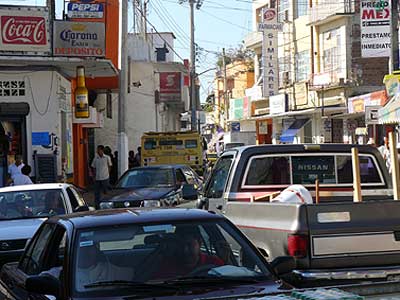 A busy day in Pochutla |
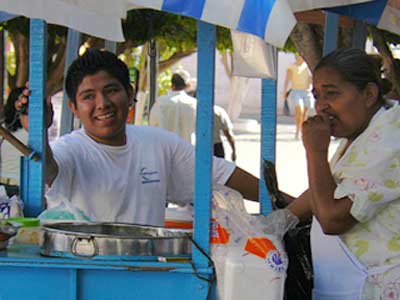 One of many street vendors selling drinks and snacks |
|
Pochutla is the closest big town to San Agustinillo, the closest place with a bank or even with proper telephone service. It's a hot, busy, and completely un-touristy place, and we make nasty jokes about it all the time, but in fact we kind of like it — perhaps because it's such a "regular place."
|
|
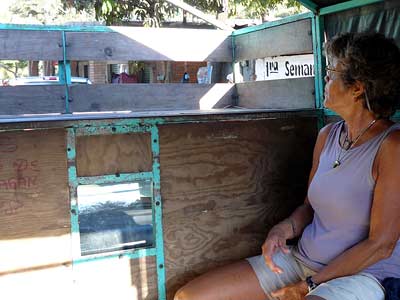 |
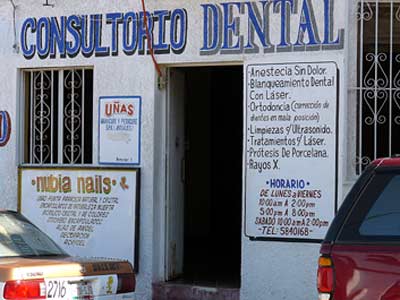 |
|
Riding in the back of a camioneta
|
The unassuming office of our dentist,
Dr. Omar
|
On this trip we've spent more time in Pochutla than usual, largely because we both decided to have dental work done here. We've been riding the camionetas — small pickups with canopies and benches in the back — at least once a week.
If we judged our new dentist by the outside appearance of his office, we would never think of going to him. But as with much else in Mexico, superficial appearances can be deceiving. Several prosperous and well-educated people in San Agustinillo insist that Doctor Omar, as everyone calls him, is wonderful, so we decided to give it a try. He is in fact highly competent, careful — and also, Barbara points out, very good-looking. So if we want a break from the beach, we go up to Pochutla and have a filling done or a crown made.
But of course the whole point of being here is San Agustinillo — our favorite beach.
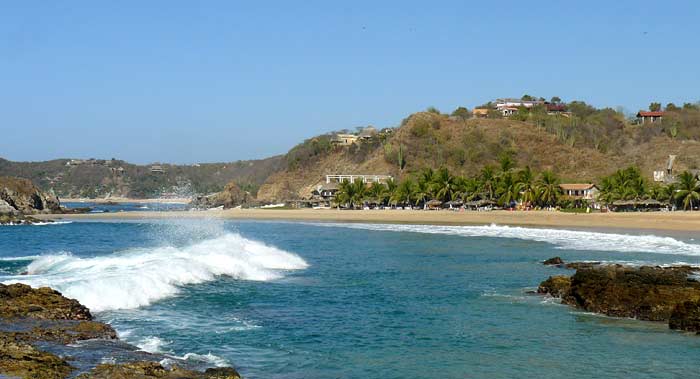
Playa San Agustinillo
We've nattered on about San Agustinillo to almost everyone who will be likely to see this website, so we won't bother singing its praises. Some of you who have been here may be interested to see photos of the "new, expanded" Posada la Barca, where we are again staying. Also, you may want to know that there have been quite a lot of new, small homes and a few new tourist accommodations and restaurants built in the last couple of years, but on the whole the place has not changed much, at least not changed for the worse.
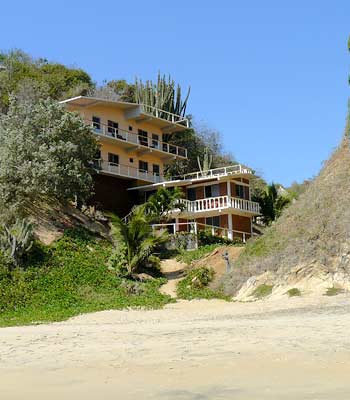 |
Here is Posada la Barca today. The original structure below has now been topped by six new units on two levels. Our room is at the very top left, with possibly the best view. We were worried that with the current economic catastrophe, Jose might have invested too much in this expansion and might now be losing his shirt. In fact, there seems to be a good occupancy rate. Since we've been here, it's varied from half full to totally full, which is darned good off season. And Jose, here this time without his wife Nadia, seems well and in good spirits. Wireless Internet (via satellite) is being added in the next day or two, and Jose aims to build a palapa roof with hammocks and other amenities above the flat roof deck at the very top. That will be fabulous! |
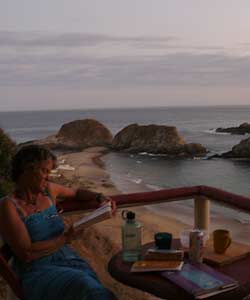 On our balcony, early evening |
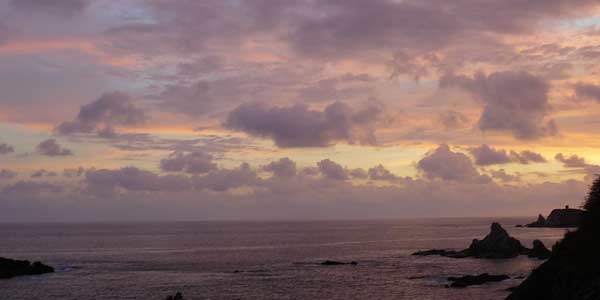 The view from the balcony at sunset |
We may add a few more pictures, especially
of people we have met here. However, for now, we want to end with an editorial
comment.
Editorial
With our little laptop, we've listened here in Mexico to a few podcasts of Public Radio shows from the U.S. Recently a caller on the Diane Rehm show insisted that the U.S. State Department should be doing everything it can to prevent U.S. citizens from traveling to Mexico. He said that Mexico is possibly the most dangerous terrorist threat our country faces, and he mentioned some grisly assassinations to support his point.
We are aware that much publicity has been given in the U.S. to violence in Mexico. However, it's long past the time when we should have learned that the media, even if they are trying to be responsible, give at best a flawed picture of what's happening in other parts of the world.
The violence that is occurring here is something like a brutal, low-level war between narco-trafficers, members of the police and the army. One important point is that the troubles seem to be confined to a number of specific areas, mostly but not entirely in the north. Think Eliot Ness and the gangsters of Chicago in the 1930s. They gunned each other down, but if you lived in Vermont or Virginia, would you have felt threatened? Remember that the distance from Mexico's border with Texas to Mexico's border with Guatemala is something close to the distance from New York to San Francisco. It's a very big country, and most of it is peaceful. Even in areas where violence has occurred, victims are usually confined to the narco-trafficers and the police or military. Except in the worst areas along the U.S. border, where we have never gone, guests are at little risk.
Even more important, many North Americans have a terribly inaccurate sense of what Mexico is really like. Somehow many of us have gotten it into our heads that Mexico is a more violent society than ours. Other inaccurate stereotypes include the notion that Mexican drivers are aggressive and reckless, or that the people are lazy and unsophisticated.
In fact, spending so much time here in Mexico we are impressed by the graciousness and kindness of Mexican people. We've cycled on Mexican roads for thousands of miles over several years now, and we are constantly surprised by how considerate the drivers have been. People have never stopped working hard here — they've never been rich enough to do so. And as for unsophisticated — this is a country with multiple impressive cultures that are still represented in extraordinary museums and cultural events, and are widely appreciated by people today. Many Mexicans rich and poor show a courtesy, a dignity, that are the very opposite of unsophisticated.
Just a few more words about the narco-trafficing and the violence that undeniably plague some parts of Mexico. If ever we Americans are tempted to think less of Mexico because of these troubles, we should remember two things: First, we Americans are the by far the biggest consumers of illegal drugs and our money drives the whole terrible business; and second, we are also the principal provider of the weapons with which narco-trafficers are often able to outgun police and army detachments. There are reasons that the worst violence by far is in towns along the U.S. border. We are far from innocent in these troubles.